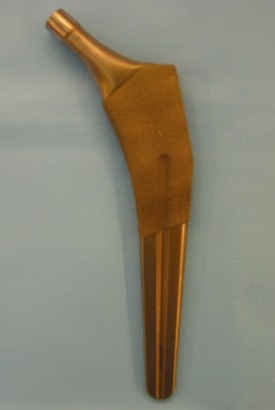CHAPTER 19 The Cementless Tapered Stem
Achieving optimal cementless fixation of the femoral component is essential to the long-term success of the total hip arthroplasty. Optimal fixation affords the patient a predictable and durable result. Gentle, safe, and adequate exposure is required for proper component placement and for obtaining optimal initial fixation of the femoral component. Several successful cementless techniques exist, such as the proximal-fit tapered wedge, proximal fit-and-fill, distal fixation with a fully coated stem, and modular variations of these stems. The goal of a tapered stem (Fig. 19-1) is to create a tight wedge-fit in the coronal plane using the tapered geometry of the stem. The component does not fill the stem in the sagittal plane. Intuitively, a tapered wedge provides more rotational stability than a component with a rod-shaped contour in an ovoid femoral canal. Another critical advantage of a tapered stem is its ability to subside, even after what appears to be firm impaction at the time of surgery, to a position of stability. This is not a feature of circular, rod-shaped fit-and-fill components.
COMPONENT DESIGN
Modulus of Elasticity
The primary materials used for femoral stems are cobalt-chromium and titanium alloys. Both alloys have demonstrated excellent mid- and long-term results.1,2 Theoretically, the modulus of elasticity of titanium more closely approximates that of bone and may lead to less thigh pain. However, this has yet to be borne out in clinical studies of this type of implant.













